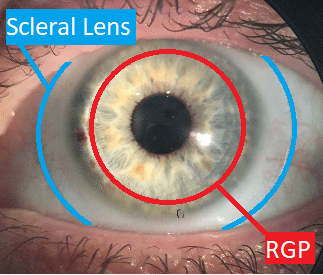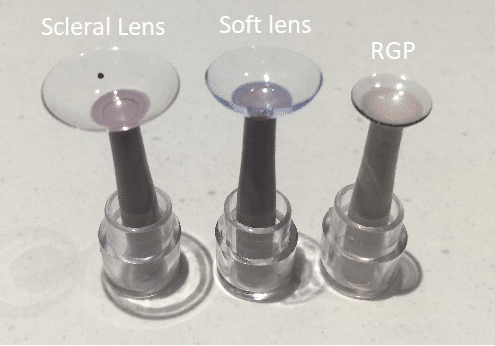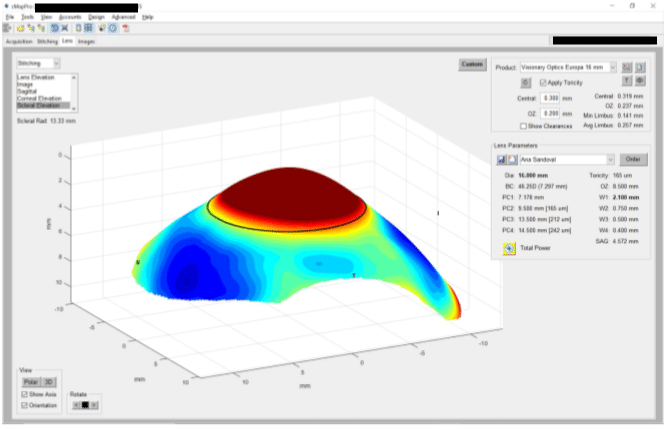Who are Scleral Lenses for?
Scleral lenses are recommended when:
- Other types of contact lenses or glasses don’t sharpen your vision
- You can no longer tolerate other types of contact lenses.
What are Scleral Lenses?
Rather than covering only a portion of the cornea, scleral lenses are large gas permeable lenses that dome over the entire corneal surface and rest on the sclera (the ‘white’ of the eye).
Their larger size makes them more stable on the eye, making them more comfortable for people with sensitive or irregularly shaped corneas.
Read more in our Scleral Lens Information PDF
Are Scleral Lenses the best option for you?
If you have one of the following conditions, it’s worth coming in so we can find what’s best for you:
| Term | Translation |
| Keratoconus | Cone-shaped cornea |
| Post-refractive surgery corneal ectasia | Irregular corneal shape many years after surgery |
| Sjogren’s and Stevens-Johnson Syndrome | Damaged corneas due to extremely dry eyes |
| Irregular astigmatism | After a corneal graft |
| Ocular Graft-versus-Host Disease (GVHD) | Following stem cell / bone marrow transplant |
How do Scleral Lenses work?
In cases of early keratoconus, a soft contact lens is our first choice. But as the cornea steepens, the vision with a soft lens deteriorates, and a rigid gas permeable lens (RGP) is needed.
If the keratoconus progresses still further, the cone increases and the RGP no longer centres properly – the lens becomes uncomfortable and the vision deteriorates. At this stage, a hybrid or scleral lens is usually needed. A hybrid lens is a combination of an RGP and a soft lens, blended into one lens rather than two lenses worn together as a piggy-back system.
Scleral lenses are significantly more comfortable than a traditional hard lens or RGP as they rest on the less-sensitive sclera and not the super-sensitive cornea. This allows scleral lenses to be extremely well tolerated. Today’s sophisticated 3D eye scanners allow us to design ultra-thin lenses that contour irregular corneas with minimal movement, resulting in a lighter and healthier lens that is comfortable to wear.
In addition to keratoconus, scleral lenses are used for eyes that have undergone a corneal transplant and for people with severe dry eyes caused by conditions such as Sjogren’s and Stevens-Johnson Syndrome. The space between the cornea and the back surface of a scleral lens acts as a fluid reservoir to provide comfort for people with severe dry eyes who otherwise do not tolerate contact lenses.
New lens designs mean we can now use progressive or bifocal scleral lenses to correct presbyopia.
The Fitting Process
We use the Pentacam WAVE AXL to develop a 3-dimensional model of each eye we treat. With this model of the eye, we can design lenses with the least amount of lens material and tear film possible. This allows the maximum amount of oxygen through to the eye, resulting in the healthiest and most comfortable lens possible. And while this part of the process is time consuming on our side, it dramatically increases the accuracy of the fit on the eye which in turn reduces the number of lens remakes and times you have to come in (wastes less of your time) so we think it’s well worth it.
Advanced technology
The Pentacam WAVE AXL provides us with
- A 3D model of the eye
- Digital scans and lens-design software
- The thinnest, lightest, healthiest lenses possible
Read more in our Scleral Lens Information PDF
Handling Scleral Lenses
Many scleral lens wearers have previously worn soft or RGP lenses, so they can insert and remove the scleral lenses fairly easily. However, there are some new skills to learn and we allow time to teach them to you. After that, it’s up to you to practise and become proficient.
Costs
Scleral lenses are not cheap – we acknowledge this and do everything we can to reduce the time needed to fit you with lenses. The Pentacam WAVE AXL reduces the number of lens remakes and times you have to come in. However, if you’re considering scleral lenses, it’s best to understand that complex corneas are often unpredictable and require complex solutions. Even with the most advanced equipment, your eyes might require several adjustments to your lens and the full fitting process might take several months to find the best lens for you.
Read more in Scleral Lens Information PDF
What’s the Next Step?
If you’re interested to know if you’re suitable for scleral lenses or would like to know more about them, please book in to see either Jenny Wu or James Simpson.
Read more in our Scleral Lens Information PDF





